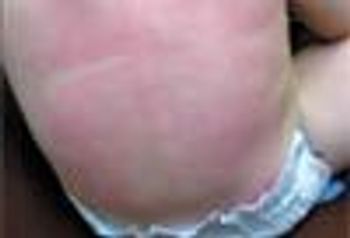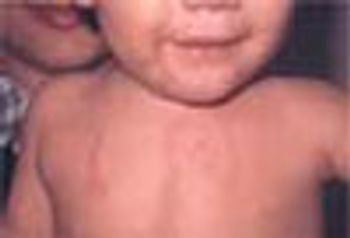
The parents of a 3-week-old infant are concerned about the numerous small, erythematous papules and pustules on his cheeks. All the lesions were at a similar stage in development. The pregnancy was uneventful.

The parents of a 3-week-old infant are concerned about the numerous small, erythematous papules and pustules on his cheeks. All the lesions were at a similar stage in development. The pregnancy was uneventful.

These pinpoint pustules, some with excoriations, and surrounding erythema appeared on the posterior trunk (A) and outer arms (B) of a 15-year-old boy after he had wrapped his upper body in a wool blanket. These lesions were occasionally pruritic, especially on the arms, where most of the excoriations were noted.

Your doctor has just told you that you have a herpes simplex virus infection (herpes). Most teens have a lot of questions about herpes. This guide will help answer some of them for you.

A 9-year-old girl presents with multiple hyperpigmented lesions, some of which have been present since birth (Figure 1). The lesions have increased in size and number. There is no history of seizures. Her 40-year-old mother has multiple skin nodules (Figure 2).

A 10-year-old girl has had a worsening rash for 1 week. The mildly pruritic, nontender eruption initially appeared on the child's thighs and then spread to the arms and face. The child's right hand, feet, and ankles have been swollen for the past 4 days, which has made ambulation intermittently painful.

We heard from several readers about a Photo Essay we recently published in our February issue entitled "The Butterfly Technique: A New Method of Inserting an Umbilical Vessel Catheter."1 The authors, Lisa A. Wood, MD, and Mark J. Polak, MD, described modifications of standard catheter insertion techniques that facilitated successful line placement.

Poisons have been a threat to the health and well-being of humankind for millennia. Given the ubiquitous nature of potential poisons, exposure to a toxin should be included in the differential diagnosis of patients with unexplained illnesses or unusual presentations.

An otherwise healthy 10-month-old boy was brought to an allergy clinic for evaluation of atopic dermatitis and chronic rhinitis. On arrival at the clinic for aeroallergen and milk prick skin testing, a rash was noted that was different from his usual atopic dermatitis. The rash had not been present 2 hours earlier when the mother dressed the child and placed him in his car seat during the ride to the clinic.

The lashes on this 12-year-old girl's right eye are white and gray; the lashes on the left eye are black. This small patch of white-gray hair, known as poliosis, occurs most often along the forehead (the so-called white forelock); however, hair anywhere on the body can be affected. The appearance in healthy persons simply indicates a lack of pigment in the hair and skin of the involved area.

The FDA recently approved Vusion, an ointment specifically formulated for the treatment of diaper dermatitis complicated by Candida in infants 4 weeks and older. Manufactured by Barrier Therapeutics, Vusion is, according to Barrier, the only prescription product approved for the treatment of diaper rash in the US.


The parents of a 2-month-old infant were concerned about a gradually enlarging reddish mass in the inner canthus of their daughter's left eye. The 3-cm mass had been present for several weeks. It became engorged when the child cried or strained.

This day-old, macular, blanching, nonpruritic rash had developed in the right axilla and on the right arm and right side of the trunk of a 3 1/2-year-old boy. He was otherwise asymptomatic. Other physical examination findings were unremarkable.

The mother of a young child was concerned about these hyperpigmented streaks that had appeared on her son's upper chest during the previous 2 weeks. Initially, the streaks were erythematous. They were completely asymptomatic, and the child was otherwise healthy and taking no medications.

Gonorrhea (aka "the clap," or "the drip") is caused by sexually transmitted Neisseria gonorrhoeae--a Gram-negative diplococcus. One of the most common reportable diseases in the United States, gonorrhea frequently affects sexually active adolescents. Approximately 30% of the 350,000 annual cases involve 15- to 19-year-olds. (That percentage is thought to be an underestimate!) Those most often infected are young women 15 to 24 years old. Recent data suggest that infection rates are higher among teens who are homeless or pregnant, and in those from a minority group or an economically disadvantaged background.

A 16-month-old previously healthy child is hospitalized after 36 hours of worsening painful edema and erythema of the right lower leg and high fever with chills.

I was asked to see this child by her physician who was concerned that these lesions were a neoplastic event. The physician wanted a dermatologist's opinion and a biopsy to guide treatment decisions. Needless to say, the child's parents were distraught. The child was happy, playful, and not at all disturbed by the rash.

Can you identify this asymptomatic lesion on the neck of a healthy 14-year-old boy?

Seven-year-old girl with generalized rash that started as a single isolated oval lesion on the lower abdomen. Six days later, diffuse papulosquamous lesions appeared mainly on the trunk, sparing the scalp, face, and extremities. Intense itching despite 3 days of diphenhydramine therapy.

The American Academy of Dermatology (AAD) and the National Jewish Medical and Research Center (NJMRC) have issued statements protesting new black box cancer warnings that the US Food and Drug Administration (FDA) has ordered on Elidel Cream (pimecrolimus; Novartis) and Protopic ointment (tacrolimus; Astellas Pharma US, Inc.), both use to treat atopic dermatitis (eczema).

An 8-year-old boy is assessed on the same day that he passed red-colored urine. The boy first noted the abnormal-colored urine when he voided on awakening.

Photo Finish: Acute Dx: What Cause of Sudden Illness?

A 7-week-old white boy presented to the emergency department (ED) with vomiting and weight loss. His parents brought him to the ED 3 weeks earlier after he had vomited for several days. Possible milk protein allergy was diagnosed at that visit, and a change from cow milk formula to an elemental formula was recommended. Vomiting subsequently increased in frequency. Nonbilious but forceful vomiting occurred with each feeding. The patient lost nearly 2 lb during the 3 weeks that followed the first ED visit.

An otherwise healthy 11-month-old infant hadhad an intermittent, nonpruritic rash for mostof his life. The lesions recurred mainly onthe extremities and trunk without a particulartrigger. Applications of 1% hydrocortisonecream were only partially beneficial. The joints and nailswere not affected. The patient’s maternal grandfather hadsevere psoriasis.

A white ring recently developed around this lesion on the upper back of a 15-year-old boy. Is there any reason for concern--and what clues would you use to suggest the need for a biopsy?